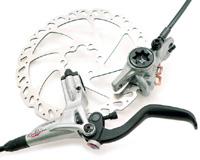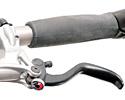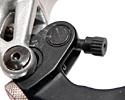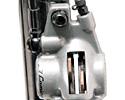
Recently on Cyclingnews.com |
On test: Hayes El Camino, January 26, 2006
Power, control and adjustability
Hayes has finally unveiled the long-awaited replacement for its venerable Mag series of hydraulic disc brakes. The El Camino offers up a variety of new features, and James Huang takes a look to see how well the new brake stacks up.

|
Does anyone even remember anymore how long Hayes has been in the bicycle-specific hydraulic disc brake market? If it seems like forever, that's because Hayes was the first widely-accepted disc brake on the market and one of the first to gain OEM spec on new bikes. Those early products offered then-unprecedented stopping power in a durable and relatively compact package.
Unfortunately, that original design has carried over largely unchanged from the late 90s all the way to last year's introduction of the new G2 caliper design. In spite of the new caliper, though, Hayes hydraulic brakes still suffered from a bit of 'on-off' modulation woes and the ergonomics were never quite spot-on. For 2006, Hayes is looking to retake the disc brake throne with the introduction of the all-new El Camino.
What's an "El Camino"?
When the folks at Hayes say the El Camino is "all-new", they're not kidding. The new master cylinder assembly signals a major departure from Hayes' styling themes of old with a very clean-looking and compact design. Much of the credit for the new, tidier appearance goes to the neatly integrated fluid reservoir. The big story with the levers, though, is the adjustability. The El Camino levers offer both tool-free reach and leverage adjustment to not only customize the fit but also the lever feel. Interestingly, the leverage adjustment is not unlike Avid's Speed Dial setup on its cable-actuated brake levers. Although the El Camino obviously isn't a cable-actuated brake, the concept is the same as are the benefits.
|
|
|
|
|
|
|
|
|
In addition to the levers, Hayes also introduced an all-new caliper design. The new "mono-block" one-piece forged aluminum caliper is reportedly Hayes' lightest design to date. It is also alleged to be significantly stiffer than even the still-pretty-new G2 caliper and includes a sizeable window for ventilation. I can't verify the lightness claim, but a quick glance at the substantial webbing and bracing on the new caliper certainly makes it seem believable enough.
Finally, Hayes paid a little attention to the rotor, too. The common 6in and 8in diameters are available, but now there is also a midsized 7in rotor. This new 7in standard is definitely picking up steam in the marketplace as it provides a little more stopping power with only a modest weight penalty (8in rotors can add about 100g each as compared to 6in ones). All of the rotors use their new V-cut pattern which is said to offer increased pad contact area with decreased weight, while also simultaneously providing moderate mud clearing ability. For super muddy XC races, Hayes still offers the mud-specific Mud Cutter rotor in the 6in size.
Total weight for our 6in setup was 454g and 480g for the front and rear, respectively, including rotors and all hardware.
Bolting them on
The split clamp on the lever is absolutely a wonderful feature which I wish everyone would incorporate. Okay, admittedly, many people are using lock-on grips these days so this may not be a huge issue. However, if you're running traditional grips, getting those suckers off at home so you can slide non-split clamp levers on and off can be a major pain. Also, these levers are completely ambidextrous so there is no hose swapping required if you run moto-style.
The same post-mount-plus-IS-adapter caliper mounting standard carries over from previous iterations and allows easy fitment on both International Standard-equipped forks and frames as well as the 74mm post mount standard that Manitou pioneered (and which Marzocchi has adopted for '06). Thankfully, no paper-thin shims are required for adjustment; just loosen the bolts a hair, pull the lever to self-center the caliper on the rotor, then tighten up and go.
One nice feature on the new caliper is the rotatable banjo on the hydraulic line which allows you to adjust the exit angle of the hose as it exits the caliper body. Particularly given some of the idiosyncratic new full suspension designs around these days, it's nice to have some flexibility in placing the line during setup.
So howzit work?
The major performance features of any brake should be power and modulation, and the El Camino delivers both in spades. After a short break-in period, initial bite was positive without being too grabby and overall stopping power was more than plentiful for most cross-country applications with the 6in rotors. While I don't have numbers to support this, the new caliper design certainly feels stiffer what with the pleasantly firm feel at the lever. If there is any flex at that end of the system, it isn't readily apparent.
However, as the folks at Pirelli say in their tire commercials, "Power is nothing without control", and the El Camino satisfies this requirement nicely as well. Hayes has clearly learned some lessons from previous brakes and dialed in substantially more modulation than was previously available. The somewhat "on-off" feeling of the old brakes has been thrown out with the bathwater in favor of very precise control.
Speaking of modulation, the little Power Control dial actually proved to be quite handy. Small adjustments produce very tangible differences both in power and lever feel. Some will say that the responsibility of power modulation lies in your fingers, but this feature makes it so that your fingers have to do a little less thinking. More importantly, the combination of the Power Control dial and the reach adjustment make for an excellent combination when it comes to fit. Customizing the El Camino to fit your own paws should be no problem.
Ok, so any complaints? Maybe just a few little ones: first of all, the lever blade pivot is a tad sloppy and there isn't much you can do to tighten it up. Perhaps this is just a pet peeve, but I prefer my pivots to be slop-free or as close as is practical without binding. Although I found the tool-less reach adjustment to be quite handy, I did find its propensity to adjust itself during a ride to be a bit annoying. A dab of Loctite took care of that easily enough, though, and still allowed for frequent adjustment without the concurrent migration. Also, somewhat strangely, the lever seemed to lose some of its "snappiness" further into a ride. I don't know what the issue was here, but it was more of a subjective thing and didn't affect the braking performance at all. The folks at Hayes acknowledged each of these issues and they are apparently already being addressed with running changes in the production line so current brakes may not have these niggles.
The final word
In the grand scheme of things, the El Camino is an impressive piece of stopping hardware. Overall power is bountiful and modulating that power to the ground is eminently controllable. The tool-free adjustments are surprisingly handy and the clean styling certainly doesn't hurt. True, the El Camino isn't the lightest brake in the world, but it does fall right in the range of its main competitors and the weight makes a bit more sense when you consider that this brake is also designed to cover the full breadth of applications from cross-country to freeride and downhilling. As an all-around disc brake, this one seems to have the bases covered quite nicely, with maybe just an untied shoelace or two.
Price: US$249 per wheel (for 6in rotor; add US$10 for 8in rotor)
Weight: 454g (front), 480g (rear), including 6in rotors and all mounting
hardware
Pros: Outstanding power and excellent modulation, readily user-adjustable
ergonomics and feel
Cons: Pivot slop, occasionally inconsistent lever feel
More information: www.hayesdiscbrake.com
Cyclingnews rating: ![]()
James Huang is chief guru at mountain bike suspension site www.angryasian.com






